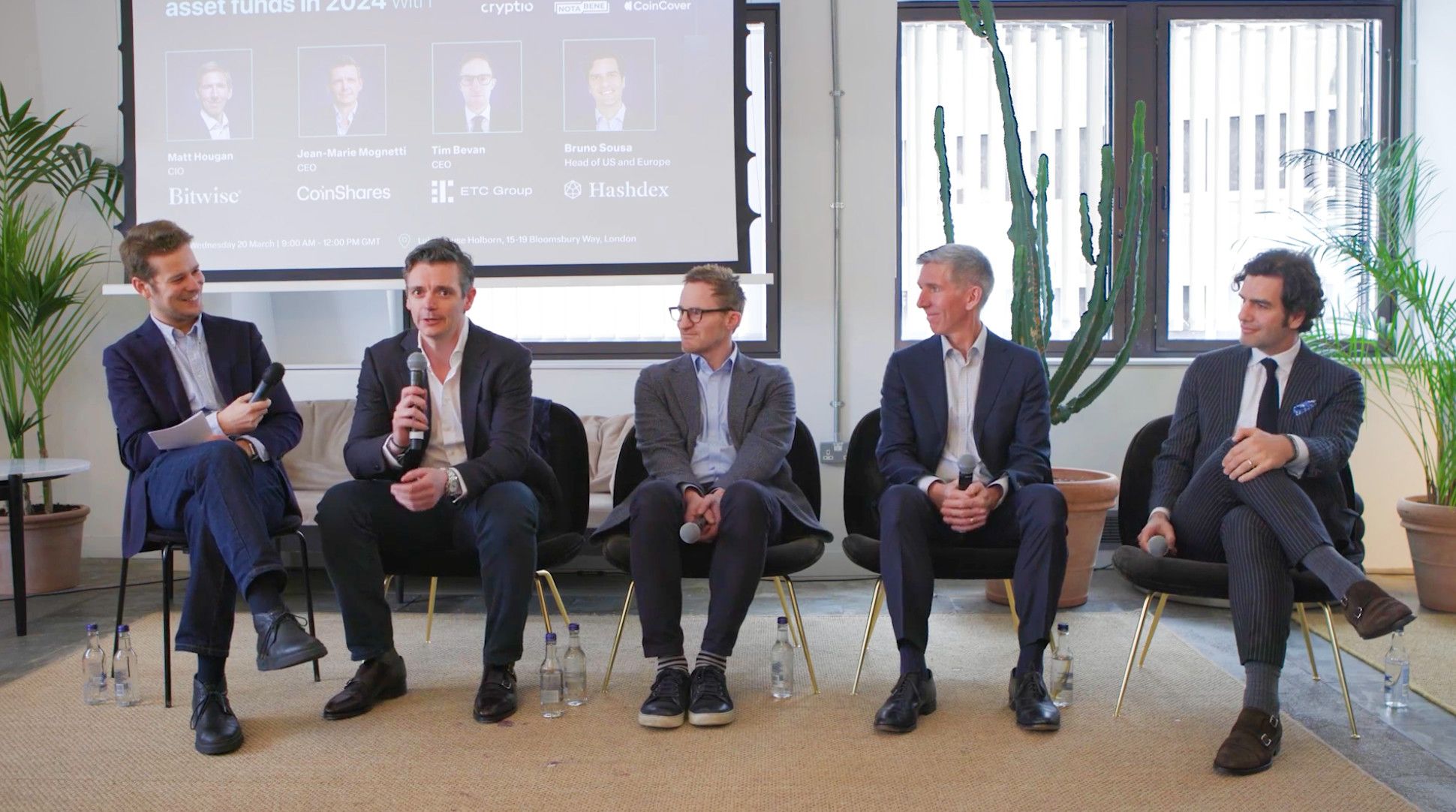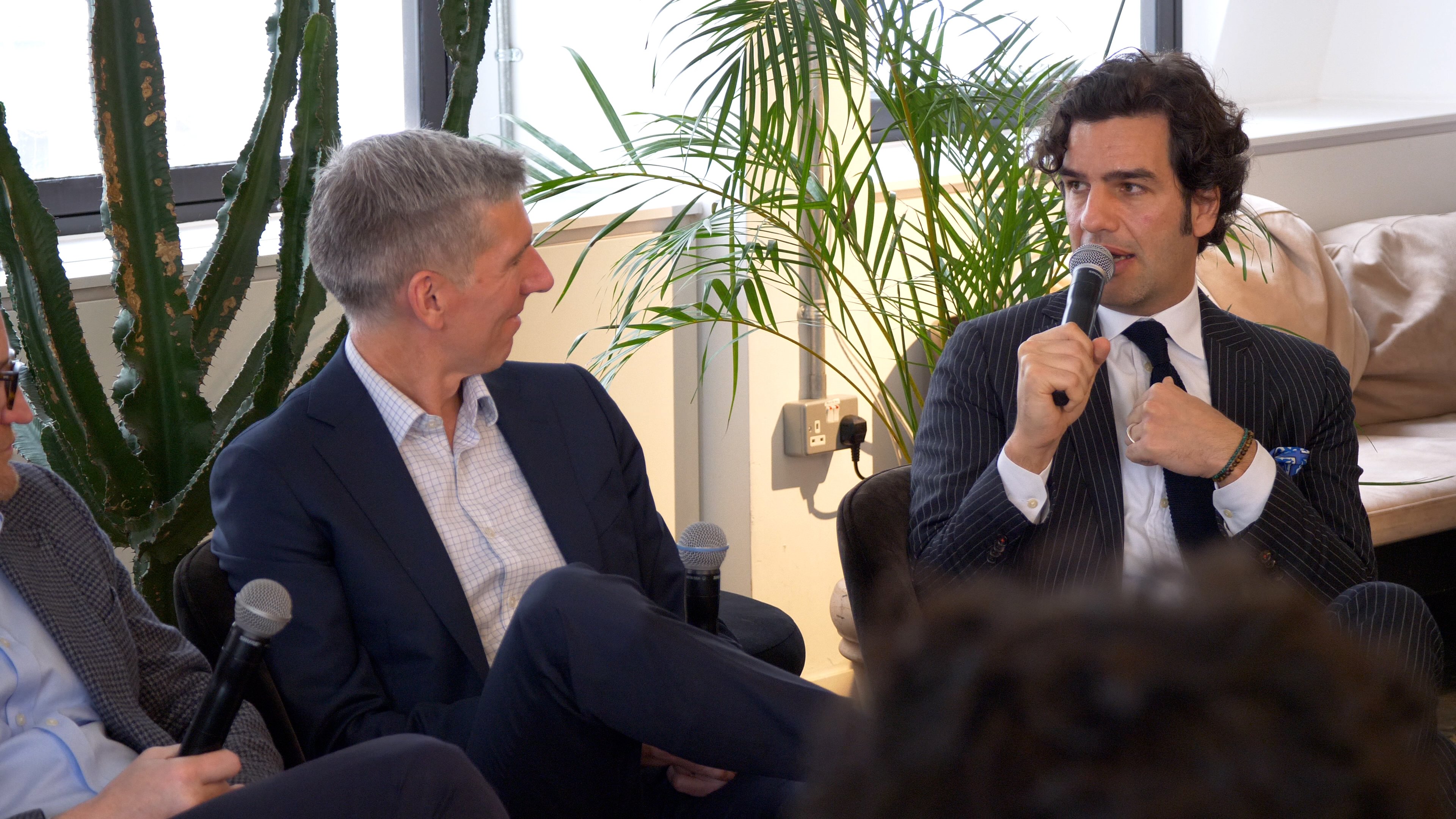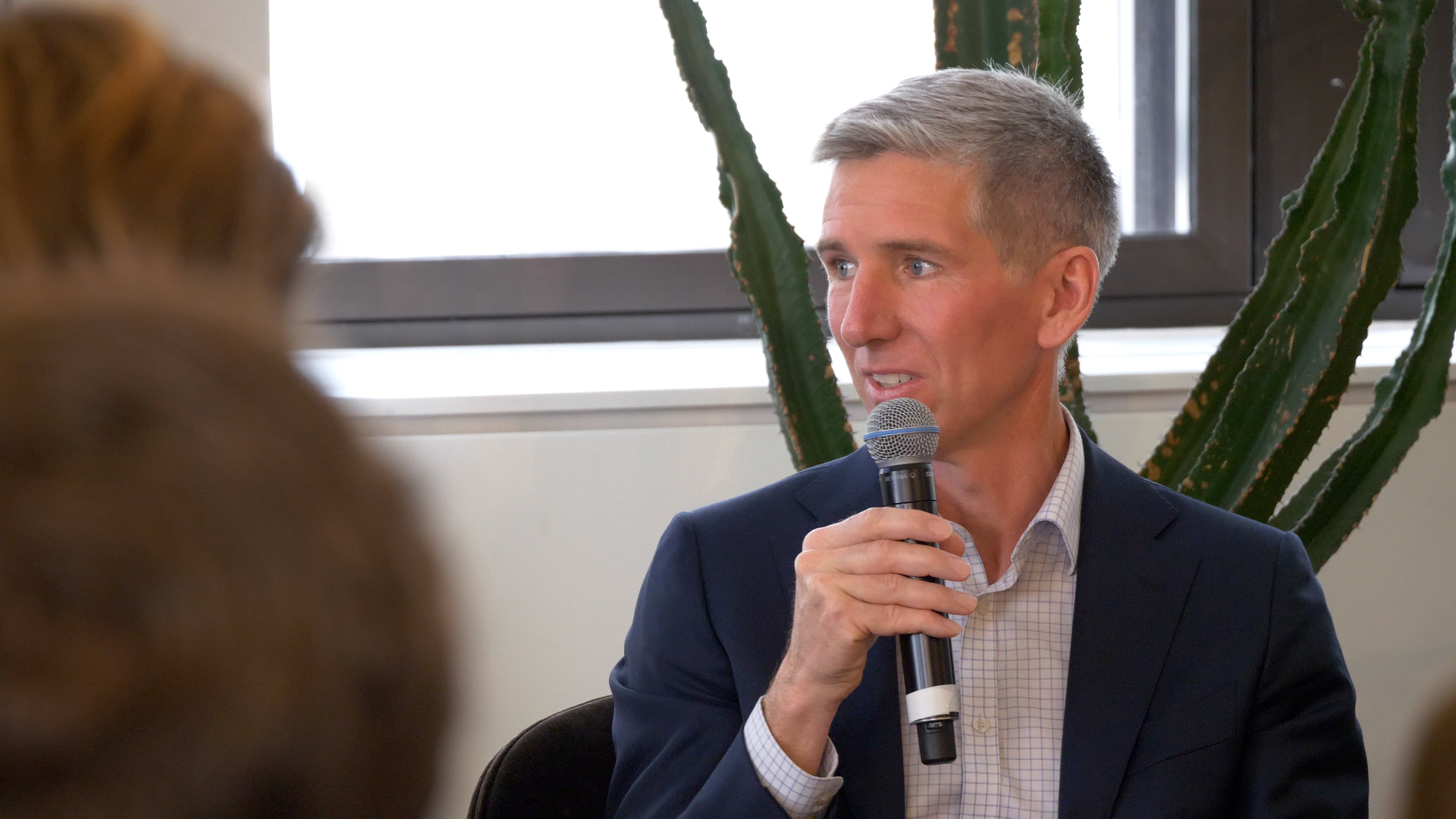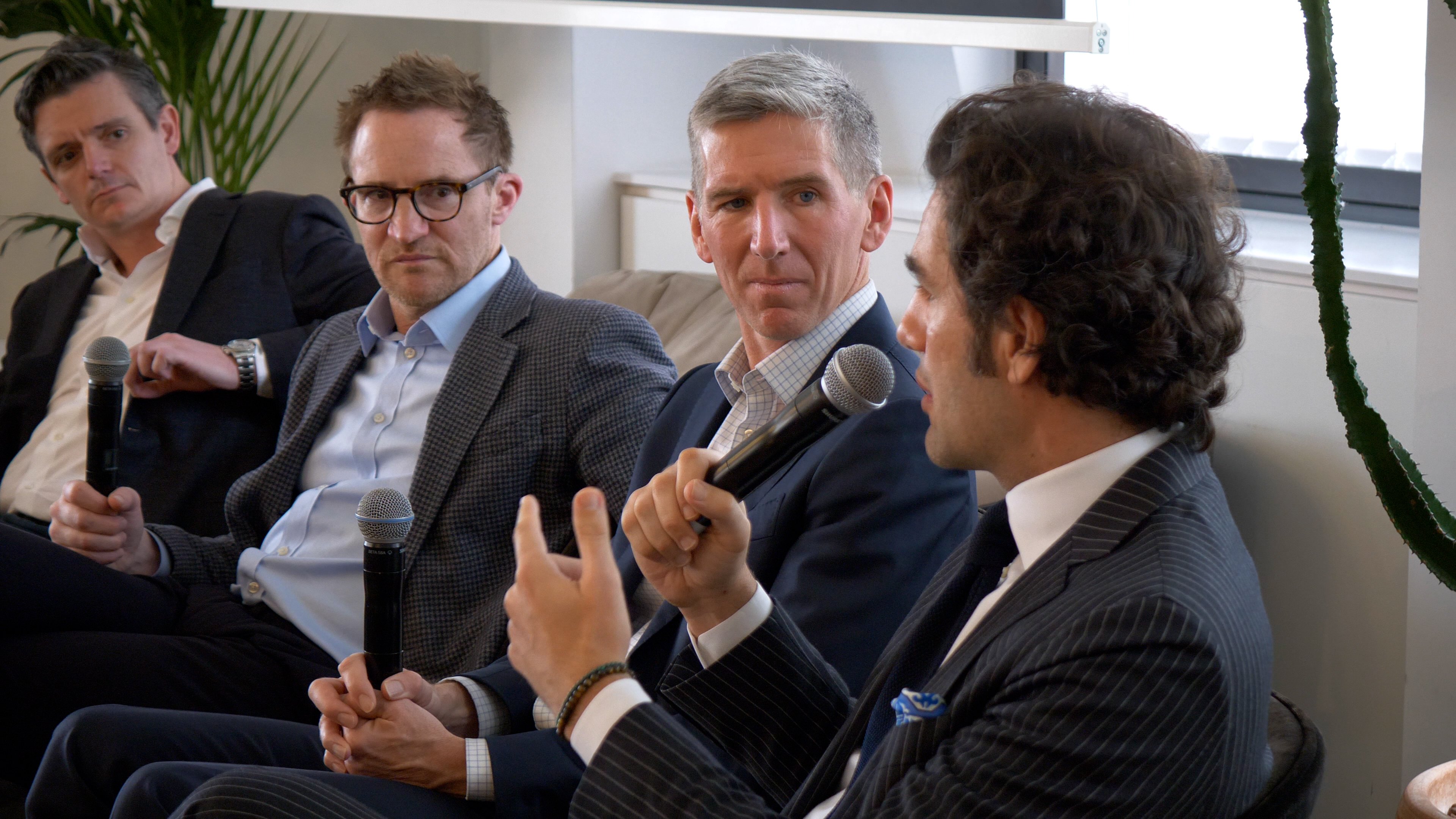Outlook for digital asset funds in 2024 with Bitwise, CoinShares, ETC Group and Hashdex
The Outlook for Digital Asset Funds in 2024 panel discussion brought together a top group of industry experts to shed light on the evolving digital asset landscape. Moderated by Antoine Scalia, Founder & CEO of Cryptio, the panel featured Matt Hougan, CIO, Bitwise, Jean-Marie Mognetti, CEO, CoinShares, Tim Bevan, CEO, ETC Group, and Bruno Sousa, Head of US and Europe, Hashdex.
The discussion focused on recent developments, regulatory challenges, market dynamics, and the potential future of digital asset funds. With the rising interest in Bitcoin spot ETFs and the broadening spectrum of digital assets, the conversation provided crucial insights into the evolving market. In this blog we summarise these key insights shared, including:
- Diverse investor base for Bitcoin Spot ETFs: highlighted the remarkable diversity in the investor base for Bitcoin Spot ETFs, including retail investors, financial advisors, family offices, and even a Fortune 500 company making substantial investments. This diversity underscores the widespread appeal of Bitcoin spot ETFs, showcasing their attractiveness across a wide spectrum of investors. Notably, while there's significant institutional interest, the current market momentum is predominantly driven by retail investors, reflecting a robust and growing enthusiasm among the general public.
- Global similarity in investor profiles: similarity in the adoption trends of ETFs and the profiles of investors across the U.S., Europe, and Brazil, underscoring a global movement towards digital assets. This similarity highlights a consistent significant retail component, complemented by institutional engagement, illustrating the universal appeal and acceptance of digital asset investment strategies.
- Profitability over AUM: prioritization of profitability over sheer assets under management (AUM) growth among fund issuers. With an expected consolidation in the U.S. Spot ETF market due to its commoditization and the challenges of maintaining profitability at current fee levels. Pointing towards a strategic shift focusing on sustainable growth and profitability, signaling a maturing market that values long-term viability.
- Regulatory landscape and market evolution: the complexities of regulatory challenges and their impact on the pace of institutional adoption, particularly highlighting Europe's cautious regulatory stance compared to the U.S.'s more open approach. Despite these hurdles, the discussion reflected a positive outlook on overcoming regulatory barriers, with the U.S. market's growth providing a hopeful contrast to Europe's conservatism, especially in the UK. This comparison underscores the critical role of regulatory environments in shaping the future trajectory of digital asset markets.
- Infrastructure and service provider concentration: there is a notable concentration of infrastructure providers like Coinbase and BNY Mellon in custody services, driven by the rigorous due diligence requirements of institutional investors. However, a diversification of providers is anticipated.
- Rise of index and non-Bitcoin products: interest in index products and non-Bitcoin digital assets is growing. These products offer an accessible way for investors to gain exposure to the broader digital asset market without detailed knowledge of individual assets.
The Bitcoin Spot ETF and its market impact

The launch of Bitcoin Spot ETFs marked a significant milestone in digital asset acceptance, appealing to a wide range of investors. Matt shared detailed observations about the diverse investor base, noting:
"We know that they're financial advisors...that are buying it in size. We know that they're family offices, including some of the largest family offices in the U.S. that are buying it. We know that there are retail self-directed investors buying it...retail is probably the largest percentage, I think it's like 90%. And we know that hedge funds, venture capital funds, and we actually had our first corporate Fortune 500 company start to build a significant position."
This diversity underscores the ETFs' broad appeal, highlighting the participation of both retail investors and significant institutional entities.
Bruno added a global perspective by comparing investor profiles across different markets, noting a significant retail component alongside institutional investors like hedge funds and family offices, particularly in Brazil and Europe. This parallel between the U.S. and other markets indicates a global trend in the ETF's appeal.
“If you connect it with what we see here in Europe and Brazil, then I'd say I probably agree with Matt that the profile is similar. If you look at Brazil, maybe 30% are hedge funds and family offices, and the rest is pure retail.”
The future of digital asset funds
Jean-Marie provided a critical outlook on the future of digital asset funds, emphasizing profitability over AUM (assets under management) growth. He critiqued the commoditization of the Spot ETF market in the U.S., predicting a necessary consolidation among players to sustain profitability.
Jean-Marie’s commentary, "AUM is for vanity and profitability is for sanity," highlighted the stark reality of fund management, where substantial assets under management do not necessarily translate into financial success.

Noting that Europe was the first region where fees were decreased, with only Barry Silber and Grayscale in the U.S. slowly following in Europe’s footsteps. Jean-Marie added:
“Europe was a very differently structured market. It was kind of first mover advantage in Europe. Nobody was doing it outside of Europe. Barry Silber and Grayscale were starting to do it slowly in the U.S., but it was very early days, so the fee compression in Europe didn't play the same way. Of course, the fees are dropping now, and that's going to also create some competition issue and consolidation, because not everybody in Europe can lower their fees to remain competitive."
Regulatory landscape and market evolution
The regulatory environment remains a significant hurdle for the digital asset space. Tim discussed the sluggish pace of institutional adoption in Europe, attributing it to regulatory challenges and a lack of understanding among traditional financial institutions.
“People overstate the speed and degree of institutional adoption (in Europe) it just isn't there yet. So the market in Europe is largely retail. Private banks or wealth managers, where they're coming under pressure from their clients or maybe family offices with a flattered decision-making structure are coming into the market. But genuine institutional adoption isn't there yet. So there's a long way to go.”

Jean-Marie contrasted this with the U.S. market, where a more receptive regulatory environment has fostered growth. However, he lamented the UK's conservative approach, which has stifled innovation and positioned the country far from its aspiration to become the Singapore of Europe.
“Brexit was a promise of creating the Singapore of Europe. We're clearly very far away from that, either from a tax perspective or simply from an innovation perspective.”
Beyond Bitcoin – the rise of index and non-Bitcoin products
Bruno emphasized the foundational approach of Hashdex, which prioritized index products from the beginning. He noted the challenge in discussing Bitcoin with financial professionals due to different opinions on cryptocurrencies. He highlighted the advantage of positioning non-Bitcoin assets and index products as part of a broader tech sector, which is less intimidating for those unfamiliar with specific cryptocurrencies like Chainlink.
“How we position the index narrative over the years, which is, this is an important tech sector you should take a look at. Bitcoin is a part of it. But there's so many other things, instead of picking where is by the market, right? So there's a big appeal to a certain type of investor, and it takes you out of the discussion on monetary policy and what's happening in Argentina or things like that.”

This strategy aims to sidestep the heated debates surrounding monetary policy and focuses on the technological innovation within the digital asset space. Bruno's perspective underscores the appeal of diversification within digital assets, beyond just Bitcoin and Ethereum, to capture the broader potential of the technology.
Tim pointed out the clear distinction between Bitcoin and all other digital assets, stating:
"There's Bitcoin and there's everything else. Bitcoin is a standalone asset. It really is in a category by itself. And I think indices are important. Right. How many portfolio managers in Europe are you going to have a discussion on the relative merits of competing layer ones with."
He argued for the importance of index products as essential tools for investment in a market characterized by significant experimentation and variance in success. Tim suggested that for most investors, especially those not ready to dive into the nuances of different protocols, index products represent a sensible way to participate in the digital asset market.
Matt shared his bullish stance on the potential market size for index products, suggesting that they could rival or even surpass Bitcoin and Ethereum ETFs in terms of market capitalization if launched simultaneously.
“We (Bitwise) run the largest index product in the US and it's our flagship. I think if you had a Bitcoin ETF, an ETH ETF and an index ETF all launch at the same time, I think it's a toss-up whether Bitcoin or index would have been the biggest. And I certainly think index would be significantly bigger than Ethereum.”

Matt's comments highlight the untapped potential of index funds in providing exposure to a wider array of digital assets, reflecting a belief in the growth of the digital asset sector beyond its current mainstays.
Exploring the concentration and future diversification of digital asset infrastructure providers
Matt expressed optimism about the future diversification of custody services, highlighting the initial choice of Coinbase by many due to its size, reputation, and the due diligence comfort it provides to national accounts like Morgan Stanley, Merrill Lynch, and UBS. Matt believes that as the market matures and more custodians undergo due diligence, this concentration will decrease.
“Why most people chose Coinbase, a) they're the largest, b) they do a great job, and c) if you wanted to sell into national accounts like Morgan Stanley, Merrill Lynch, UBS, et cetera, they need to do due diligence on the custodian as well….As more of these custodians have gone through due diligence at the national accounts level they're more comfortable. I think that will diversify and costs will come down, but I think that was a big driver of concentration.”
Tim pointed out the difference in the European market, noting that there is a reasonable diversity of offerings at the custody level. However, he identified a concentration issue around market making and liquidity provision, with a limited number of players dominating this crucial area. Tim explained:
“There's a limited number of players, and it's been stacked. They do an excellent job, but there's a small number of players providing liquidity across the ecosystem, especially when it comes to being registered market makers. There's only two shops in Europe that will do that. So that's probably the most acute sort of area of supplier dependency, I think, in the European model.”
Bruno reflected on the historical lack of options within the fund services ecosystem but noted improvements and diversification over time. He emphasized the evolving quality and credibility of service providers, suggesting a positive trend toward normalization and stability, especially in custody services.
“I think it's getting better. The brands are better. You don't have to choose in the past some small firm that you never heard of, but they look like they know what they're doing. So certainly if you look at the stack behind Hashdex’s products or Bitwise or CoinShares’ back in 2018, 2017, 2019, today, it's probably a lot different, a lot better than it was.”

Jean-Marie acknowledged the current concentration but predicted its gradual reduction. He emphasized the complexity of ETFs as investment vehicles and the specialized nature of the services required for their operation. He pointed to the high standards and track records of certain key players like BNY Mellon as reasons for their prevalent use, suggesting that their involvement lends credibility and fosters adoption. He remarked:
"The concentration is there and will slowly but surely be removed. Also, not to forget that ETF, despite looking extremely clean for an investor, are an extremely complicated machine under the hood. It's like a high complication watch. There's a lot of people participating in the creation, and the administration of this process, and it tends to be a very specialized shop that interacts with that.”
Diversification and growth in the digital asset landscape
In conclusion, this panel discussion highlighted the inevitability of diversification in both digital asset offerings and the infrastructure that supports them. Experts anticipate a shift towards more varied custody solutions and a broader spectrum of service providers, driven by maturation in the market and increased investor comfort and trust. From the adoption of Bitcoin Spot ETFs and the challenges of regulatory landscapes, to the potential diversification in infrastructure and the growth of index and non-Bitcoin products.
This evolution promises not only to lower costs but also to broaden market access, ensuring a robust, resilient, and inclusive landscape for digital assets. The insights from industry leaders not only reflect on the current state but also look toward continued growth and innovation.
To watch the full panel discussion visit the Cryptio YouTube channel.
Table of contents
- The Bitcoin Spot ETF and its market impact
- The future of digital asset funds
- Regulatory landscape and market evolution
- Beyond Bitcoin – the rise of index and non-Bitcoin products
- Exploring the concentration and future diversification of digital asset infrastructure providers
- Diversification and growth in the digital asset landscape





%20(1).png)

